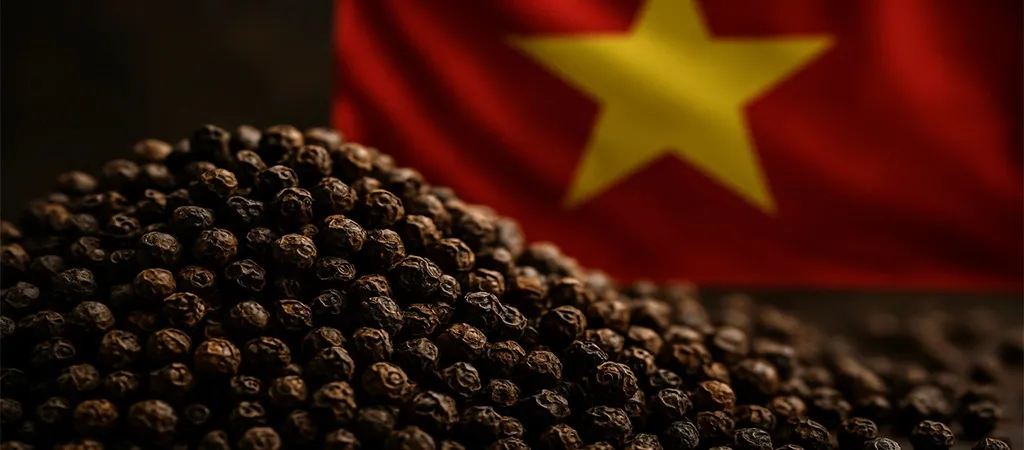India’s Turmeric Drops 15% in Production, Peru’s 70% Export Jump in January: Will Bangladesh, Myanmar, and Fiji Threaten India’s 70% Turmeric Monopoly?
In 2025, turmeric stands out among the world’s most dynamic spice markets. India, long the undisputed leader in turmeric production and exports, faces rising competition from Bangladesh, Fiji, Sri Lanka, and Myanmar, each cultivating their own distinctive varieties. Meanwhile, weather disruptions, production cuts, and evolving global consumer preferences keep turmeric prices volatile and often elevated. Below is a comprehensive market update and analysis, reflecting the latest news, production insights, key exporters/importers, product quality considerations, harvest outlook, current prices, and signals for the future. Additionally, we'll explore how geographical indication (GI) tags and India’s newly established National Turmeric Board could shape long-term prospects.

1. Latest Market Updates & News
A. India’s National Turmeric Board & the Push for GI Tags
The establishment of the National Turmeric Board marks a crucial step in India’s effort to streamline production, boost exports, and pursue more research and innovation. India already grows around 30 varieties across 20 states, holding roughly 70–80% of global turmeric supply. Yet, only 6 GI tags exist for turmeric among the 654 GI-labeled products in India’s entire agricultural sector—highlighting an underutilized tool for differentiation in global markets.
- GI Tag Importance: A Geographical Indication (GI) tag identifies products with unique qualities or reputation linked to their region of origin. When properly leveraged, GI tags shield producers from counterfeits and can fetch premium prices in export markets.
- Challenges & Potential: Many existing GI-tagged turmerics, like Erode Turmeric, have curcumin levels around 2.5–4.5%, below the 5% demanded by some global buyers. Experts encourage expanded R&D and higher-curcumin variants for new GI applications. The Turmeric Board’s role includes identifying prime cultivars, boosting value-added products, and negotiating better IP protections abroad.
B. Turmeric Production in India: Lower Output & Price Fluctuations
Indian turmeric production suffered a notable drop of 10–15% in the latest season, attributed to unseasonal rains and pest/disease outbreaks. Despite an overall expansion of cultivated area to 0.33 million hectares (+10% from last year’s 0.30 million ha), yields have been compromised by adverse weather, particularly in states like Maharashtra (Marathwada region) and Telangana.
- 2023–24 Season: India produced about 1.08 million tonnes of turmeric. Current estimates suggest only a modest or even negative shift (1.05–1.12 million tonnes), as disease outbreaks hinder orchard-level productivity.
- New Crop Arrivals: The fresh turmeric crop began arriving in major Indian markets (e.g., Nizamabad, Hingoli) in early Q1 2025, causing short-term price dips. However, prices often rebound as arrivals slow and domestic plus export demand picks up—particularly during wedding seasons and festive periods.
C. Export Demand & Global Market Prices
- Indian Turmeric Exports: Up by 10% in the 2023–24 financial year, reaching 1,22,000 tonnes. Despite a month-on-month drop in certain months, exports remain significantly higher (+50% vs. 2023), signaling stable global appetite.
- Major Buyers: Bangladesh leads with around 40,000 tonnes of Indian turmeric imports. The U.S. and the UAE also rank as critical destinations, utilizing turmeric in everything from processed spices to nutraceuticals.
- International Price Gains: Market watchers note rising turmeric prices worldwide, propelled by supply tightness and unwavering demand. India’s domestic supply constraints reinforce this global uptrend.
D. Other Players: Bangladesh, Fiji, Sri Lanka, Myanmar & Peru
While India dominates the market, others challenge its stronghold:
- Bangladesh: Not only a major buyer of Indian turmeric but also a producer. Some varieties exhibit premium color or curcumin content, generating niche interest abroad.
- Fiji, Sri Lanka, Myanmar: Each produces distinct local turmeric with unique aroma or medicinal attributes. Without strong marketing or GI tags, these origins remain smaller in scale but can capture specialty markets.
- Peru: Surged in early 2025, shipping 264 tonnes in January (up 70% year-over-year). The Netherlands (40% share) and Mexico (15%) were top buyers. Peru’s growth in turmeric showcases how non-Asian producers are emerging as global suppliers, riding the wave of healthy living trends.
E. U.S. Policy Shifts & Tariffs—Minimal Impact on Turmeric?
Recent U.S. tariff decisions—pausing duties on Mexico and Canada but imposing a 10% levy on Chinese imports—pose limited direct effects on turmeric, as major exporters are in South Asia. Nonetheless, higher inflation or shipping disruptions could indirectly influence demand or costs for processed turmeric in the U.S. consumer market.
2. Global Production Status
- India
- Produces ~70–80% of global turmeric.
- Sowing area up 10% to 0.33 million hectares, but yields fall short due to unseasonal rain and disease outbreaks.
- 1.08 million tonnes last year—similar or slightly lower forecasts for 2025.
- Bangladesh
- Produces notable volumes, though overshadowed by India. Active in cross-border trade, also re-exports.
- Maintains robust domestic demand, particularly for ground turmeric in local cuisine.
- Sri Lanka & Myanmar
- Each fosters indigenous cultivars prized in local and some niche global markets.
- Lacking large-scale expansions or robust GI frameworks, limiting global presence.
- Fiji
- Small-scale production with unique varieties; significant potential if improved branding occurs.
- Peru
- Gaining traction. In January 2025, exports soared by 70% yoy to 264 tonnes—an impetus for further growth in Latin American expansions.

3. Major Exporters & Importers of Turmeric
- Exporters: India dominates (over 70% global share), followed by smaller but growing producers like Myanmar, Sri Lanka, Peru, and certain segments from Bangladesh.
- Importers: Leading consumers include the U.S., major EU nations (Germany, the Netherlands, the UK), the UAE, and Japan. Demand is also strong in nutraceutical markets focusing on curcumin-based health products.
4. Product Quality, Harvest Time & Quality Considerations
- Harvest Seasons
- India: Usually harvested from January–April. Delays in sowing or extended monsoons can shift arrival windows by 1–2 months.
- South Asia: Bangladesh, Sri Lanka, Myanmar share similar cycles, heavily reliant on monsoon patterns.
- Peru: Harvest times can differ seasonally, but consistent with the southern hemisphere’s opposite seasonal pattern to Asia.
- Quality & Curcumin Content
- GI tags hinge heavily on curcumin levels (the key chemical conferring color and health properties). Premium markets often demand curcumin content above 5%. Many Indian GI-tagged turmerics fall below that threshold, requiring R&D to raise content.
- Post-harvest processing—proper drying, polishing, grinding—affects color, aroma, and contamination levels.
- Disease & Pest Challenges
- Powdery mildew, blight, and rhizome rot hamper yields. Integrated pest management (IPM) and disease-resistant varieties become crucial, especially under unpredictable climatic conditions.
5. Prices Now & Future Trends
A. Current Price Landscape
- India:
- Following a notable 10–15% production drop, prices hovered around USD 1.59/kg at peak. Some local markets reported short-term dips with new crop arrivals (e.g., Nizamabad, Hingoli), but any deep correction remains unlikely if yields remain tight.
- Peru:
- Although volume remains modest, strong yoy export growth could influence local farmgate prices. Gains in export markets like the Netherlands keep producer sentiment positive.
- Bangladesh & Others:
- Data sparse, but typically parallel Indian price movements, subject to currency exchange rates and local supply conditions.
B. Outlook & Signals
- Supply: Projected moderate expansions in Indian acreage do not automatically translate to higher yields if inclement weather or disease persists. Lower productivity from Marathwada (20–25% yield loss) especially curbs overall supply.
- Demand: With robust interest from nutraceuticals (curcumin supplements), food and beverage industries, and the diaspora-driven consumption, global demand shows no signs of waning.
- Price Outlook: Market watchers forecast possible short-term corrections if arrivals surge, especially in Q2 2025. However, sustained demand plus weaker supply fundamentals might push prices upward again by mid-year, aiming at USD 1.96/kg or higher.

6. Market Analysis & Signals
- GI Tags for Indian Turmeric
- Additional GI certifications, particularly for high-curcumin lines, could secure premium markets. However, they require consistent quality upgrades and long-term brand-building.
- Curcumin Demand
- Turmeric in nutraceuticals is a booming segment, with advanced economies focusing on standard curcumin extracts for immune health. Countries that specialize in higher-curcumin strains gain a competitive edge.
- Production vs. Price
- A cyclical caution: Overexpansion triggered by high prices can lead to surpluses, depressing future markets. The newly minted National Turmeric Board aims to avert such booms and busts by balancing supply with stable or value-added demand.
- Impact of U.S. Tariffs
- The paused 25% tariff on Mexico/Canada and 10% tariff on China likely have limited direct impact on turmeric flows. Indirectly, potential inflation or shipping disruptions might influence overall commodity purchasing power, but no immediate shock is expected for turmeric shipments.

7. Additional & Complementary Updates
Finally, after reviewing all content provided, here are further insights not fully discussed:
- Organic Turmeric: Some references highlight “Black turmeric” or “Pratibha turmeric” with specialized nutritional profiles. Future expansions in organic lines could capture health-conscious consumers globally.
- Trade Agreements: US or EU trade policy shifts, especially around intellectual property or tariff schedules, might shape turmeric’s competitiveness.
- US Farm Bill & Potential Influence: If U.S. farm or trade policy changes raise costs for spice importers, it could affect turmeric demand or pricing.
- Competition from Minor Origins: While overshadowed by India, places like Myanmar or Fiji can supply niche markets or ride specialty trends if they emphasize distinct flavor or color profiles.
- Peru’s 264 tons in January: This robust start underscores Latin America’s role in diversifying turmeric supply. Mexico is a key buyer from Peru, while the Netherlands leads in the EU.
- Tariffs & Shipping: The US paused tariffs on Mexico and Canada for 30 days in early 2025, focusing on Chinese goods. Although primarily affecting other commodities, any broad shipping or port disruptions can slightly hamper turmeric logistics.

Conclusion
Turmeric remains at a critical juncture in 2025, with India’s production dip fueling higher prices, particularly as global demand continues apace. Yet, expansions in cultivated area, combined with GI tags and National Turmeric Board support, promise to elevate India’s value-added potential if the sector successfully addresses disease management, quality control, and brand-building. Meanwhile, rising players like Peru highlight how a broader range of producing nations seeks to capture segments of the surging turmeric market.
Near-term pricing is likely to remain firm or even rise, reflecting lingering supply challenges and strong export orders. While short-term gluts might occur with new crop arrivals, the overarching demand for spice and nutraceutical uses bolsters optimism in the long run. Ultimately, the future success of Indian and global turmeric production hinges on balancing expansions with sustainable, premium-quality lines that secure unwavering consumer confidence worldwide.
FAQ Section
- FAQ: Why Is India Pursuing GI Tags for Turmeric?
India holds about 70–80% of the world’s turmeric production, yet only 6 GI tags exist for it. GI certifications can differentiate high-curcumin varieties, protect against counterfeits, and secure premium prices in export markets.
- FAQ: Has Indian Turmeric Production Really Declined by 10–15%?
Yes. Weather disruptions and pest/disease outbreaks impacted key regions (e.g., Marathwada in Maharashtra). Despite a bigger cultivation area, yields remain lower, causing overall output to miss earlier projections.
- FAQ: What’s Driving Turmeric Prices Up in 2025?
A combination of reduced production in India, stable global demand (including the nutraceutical sector), plus strong buying from major importers like the U.S. and the EU keeps turmeric prices elevated, with some expecting them to reach or exceed USD 1.96/kg.
- FAQ: How Are Peruvian Turmeric Exports Faring in 2025?
Peru’s January shipments grew by 70% yoy, totaling 264 tonnes. The Netherlands (40% share) and Mexico (15%) lead as top destinations, signaling strong overseas demand for alternative supply sources.
- FAQ: Will the New National Turmeric Board Transform India’s Industry?
The Board aims to boost production, R&D, and quality standards, potentially expanding GI tags and forging IP protections in trade agreements. Over time, this could stabilize farmer incomes and elevate India’s turmeric brand worldwide.
- FAQ: Are Weather & Tariffs Major Risks to the Market?
Yes. Erratic rains or pests can reduce harvest volumes. Although the U.S. tariff pause primarily affects other goods, broader economic or shipping disruptions might indirectly influence turmeric’s cost structure or consumption patterns.



